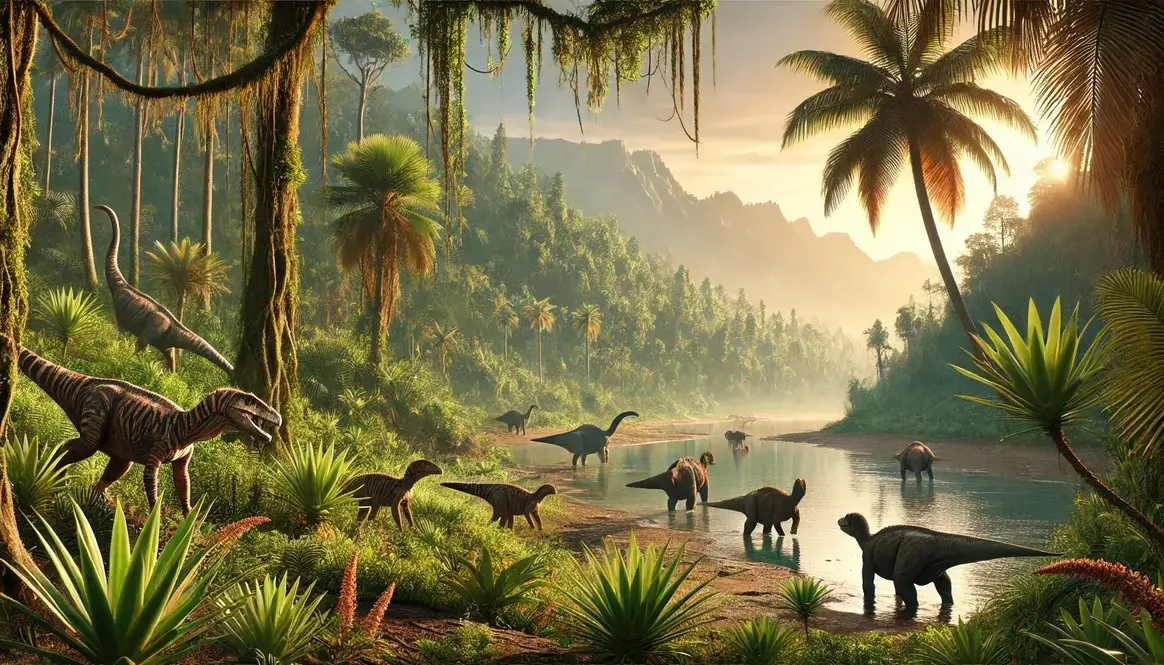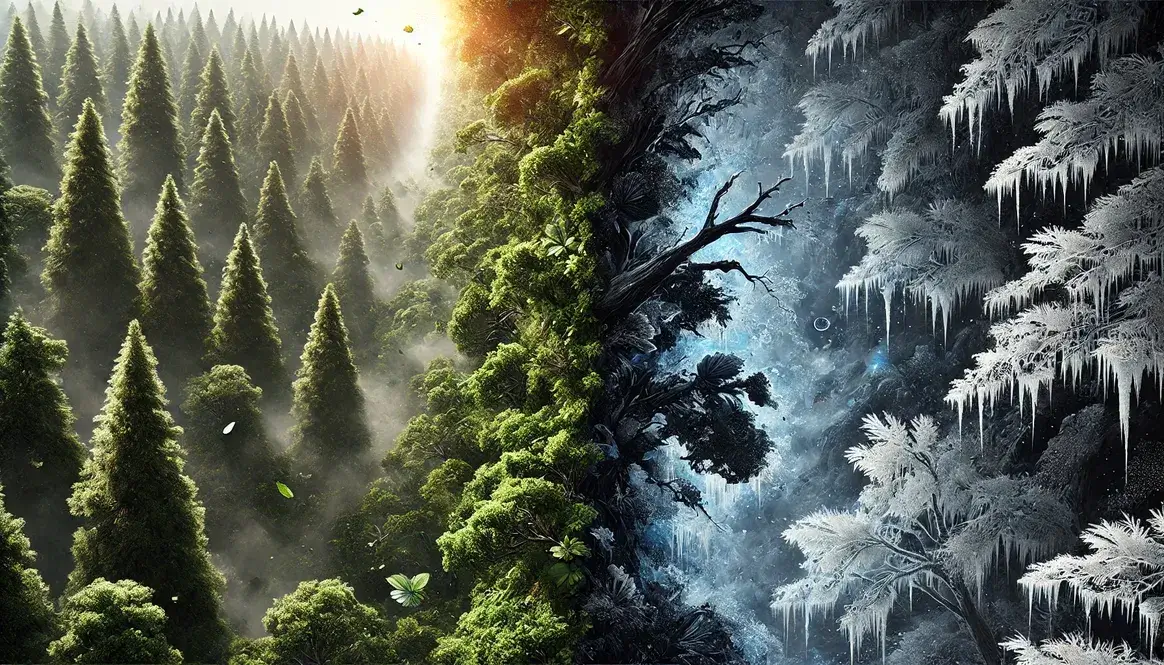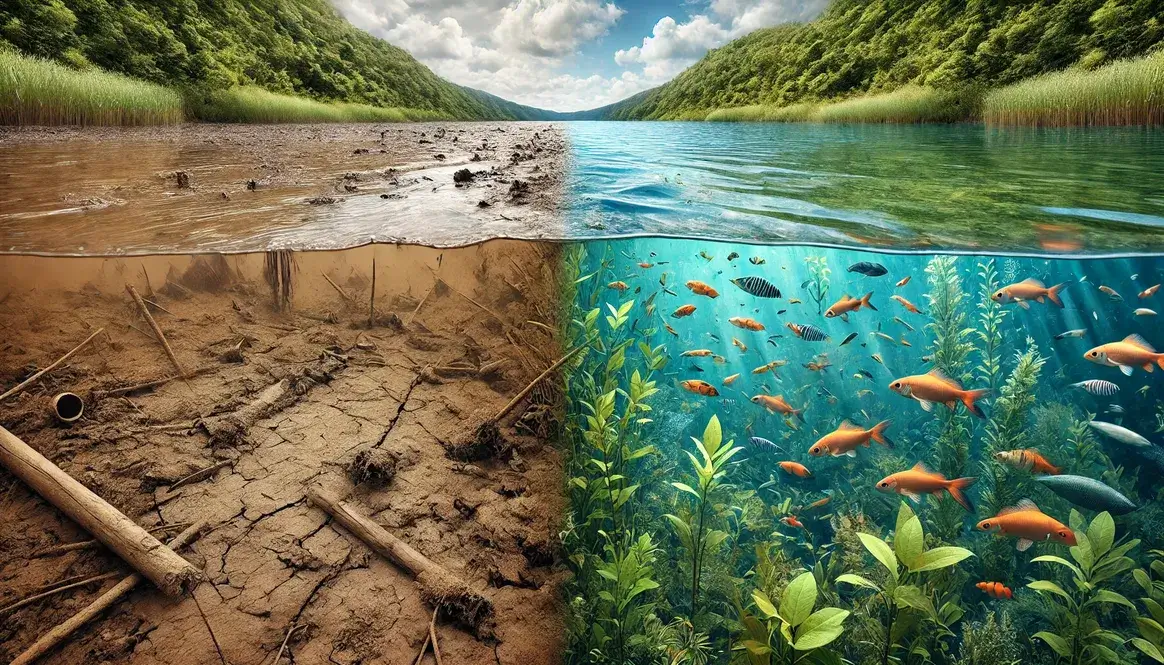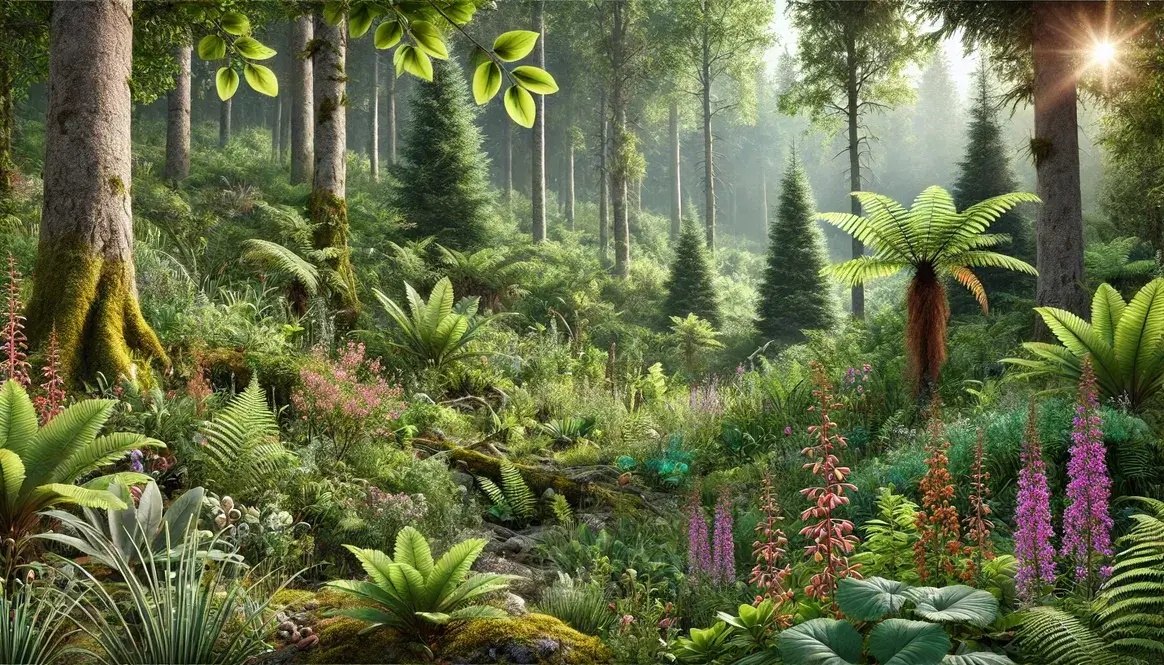Imagine a world where tropical plants grow near the poles and dinosaurs roam vast, lush landscapes. This was Earth at the end of the Cretaceous period, about 66 million years ago. The climate during this time was very different from what we experience today, setting the stage for the incredible diversity of life that existed just before one of the most famous extinction events in our planet’s history.
Understanding the climate at the end of the Cretaceous is crucial for several reasons. It helps us piece together the living conditions of the last non-avian dinosaurs, provides insights into how Earth’s climate can change over time, and offers clues about the dramatic events that led to the extinction of many species. By studying this period, scientists can better understand climate processes and how they might affect our future.
| Key Climate Features | Description |
|---|---|
| Global Temperature | Much warmer than today, averaging 18-20°C (64-68°F) |
| Polar Regions | Ice-free, with temperate forests |
| Sea Levels | 100-200 meters higher than present |
| CO2 Levels | 4-6 times higher than today |
| Climate Zones | Less extreme, more uniform globally |
What was the climate like at the end of the Cretaceous?
The climate at the end of the Cretaceous was generally much warmer and more uniform than it is today. Global temperatures were significantly higher, with little ice at the poles. The world was dominated by warm, humid conditions, even in areas that are now much cooler.
Here are the key characteristics of the late Cretaceous climate:
- Warmth: The Earth was much warmer overall, with global average temperatures estimated to be about 18-20°C (64-68°F), compared to today’s average of about 15°C (59°F).
- Humidity: Many regions experienced high humidity levels, contributing to lush vegetation growth.
- Mild Seasons: Temperature differences between seasons were less extreme than they are today.
- High Sea Levels: Warmer temperatures led to higher sea levels, with much of the continental interiors covered by shallow seas.
- No Polar Ice: The poles were free of ice, instead supporting temperate forests.
This climate created a world very different from our own, with unique ecosystems and weather patterns that supported a diverse array of plant and animal life, including the last of the non-avian dinosaurs.
Global Temperature Patterns
The late Cretaceous period was characterized by a significantly warmer climate than what we experience today. This warmth had a profound impact on the Earth’s ecosystems and the creatures that inhabited them, including the dinosaurs that lived in the Arctic.
Average Temperatures
During the late Cretaceous, the Earth was considerably warmer than it is now. Scientists estimate that the global average temperature was about 18-20°C (64-68°F). To put this into perspective, our current global average temperature is around 15°C (59°F). This means the world was about 3-5°C (5.4-9°F) warmer overall.
This warmth was not evenly distributed across the planet, but it did create a more uniform climate than we see today. The higher temperatures were largely due to increased levels of greenhouse gases in the atmosphere, particularly carbon dioxide.
| Time Period | Average Global Temperature |
|---|---|
| Late Cretaceous | 18-20°C (64-68°F) |
| Present Day | 15°C (59°F) |
| Difference | +3-5°C (5.4-9°F) |
Temperature Variations
While the Earth was generally warmer during the late Cretaceous, there were still temperature differences between various regions and seasons. However, these variations were less extreme than what we observe in the modern world.
- Equatorial vs. Polar Regions:
- The equatorial regions were warm, much like they are today, but not significantly hotter than our current tropics.
- The most striking difference was in the polar regions. Unlike the ice-covered poles we know today, the Cretaceous polar areas were ice-free and much warmer.
- Temperatures at the poles may have averaged around 10°C (50°F), allowing for the growth of temperate forests.
- Seasonal Fluctuations:
- Seasonal temperature changes were less pronounced than they are today.
- Winters were milder, especially in higher latitudes.
- Summers were not necessarily hotter than today’s summers in most regions.
This more uniform climate had significant implications for life on Earth. It allowed plants and animals to thrive in areas that would be inhospitable today. For example, fossils of plant adapted to Cretaceous climate have been found in polar regions, indicating the presence of forests where we now find tundra or ice sheets.
The warmer temperatures also contributed to higher sea levels, as there was less ice locked up in polar ice caps. This created shallow seas over many continental areas, further influencing climate patterns and the distribution of life.
Rainfall and Humidity in the Late Cretaceous
The Late Cretaceous period wasn’t just warmer than today; it also had a distinct pattern of rainfall and humidity that shaped the landscapes and ecosystems of the time. These conditions played a crucial role in supporting the diverse plant and animal life, including the last non-avian dinosaurs.
Precipitation Patterns
During the Late Cretaceous, Earth experienced a unique distribution of rainfall that differed significantly from what we see today. The warmer global temperatures led to increased evaporation and a more active water cycle.
Key features of Late Cretaceous precipitation patterns:
- Increased Global Rainfall: On average, the Earth received more rainfall than it does today, particularly in areas that are now arid or semi-arid.
- Expanded Tropical Belt: The warmer temperatures allowed the tropical rainfall belt to extend further north and south than it does in our current climate.
- Wetter Mid-Latitudes: Regions that today experience Mediterranean or temperate climates were generally wetter during the Late Cretaceous.
- Less Extreme Deserts: While arid regions still existed, they were typically less extreme and more localized than modern deserts.
The impact of continental positions also influenced rainfall patterns. As landmasses were arranged differently, ocean currents and wind patterns varied from what we observe today, affecting where and how much rain fell.
Monsoon Systems and Their Impact
Monsoon systems during the Late Cretaceous were more intense and widespread than they are today. These powerful seasonal wind shifts brought heavy rains to many coastal and inland areas.
- Expanded Reach: Monsoon effects reached further inland due to the presence of large inland seas.
- Increased Intensity: Higher global temperatures led to stronger temperature contrasts between land and sea, intensifying monsoon systems.
- Ecosystem Support: These monsoons supported lush vegetation in areas that might otherwise have been drier, providing food and habitat for various dinosaur species.
Humidity Levels
The Late Cretaceous world was generally more humid than our present climate. This increased moisture in the air had significant effects on both the environment and the creatures that inhabited it.
General humidity conditions:
- Higher Overall Humidity: Most regions experienced higher humidity levels than their modern counterparts.
- Reduced Daily Temperature Fluctuations: Increased atmospheric moisture helped moderate temperature swings between day and night.
- Enhanced Plant Growth: Higher humidity supported lush vegetation, even in areas that would be considered marginal today.
Regional variations in moisture were still present, though less pronounced than in our modern world. Some notable differences included:
- Polar Regions: Unlike today’s dry polar climates, Late Cretaceous polar areas were surprisingly humid, supporting temperate forests.
- Continental Interiors: While still drier than coastal areas, inland regions were generally more humid than they are today, partly due to the presence of inland seas.
- Coastal Areas: Extremely humid, with frequent rainfall and lush vegetation.
- Equatorial Regions: Similar to today’s tropical rainforests, but potentially covering a larger area.
This humid environment had a profound impact on the storms and weather patterns of the Late Cretaceous. The combination of warmth and moisture likely led to more frequent and intense storms, shaping the landscapes and influencing the evolution of the creatures that lived through them.
Understanding these precipitation and humidity patterns helps us paint a more complete picture of the world in which the last dinosaurs lived, providing crucial context for their evolution and eventual extinction.
Climate Zones of the Late Cretaceous
The Late Cretaceous world, while generally warmer and more humid than today, still had distinct climate zones. However, these zones were quite different from what we see in the modern world. Let’s explore the characteristics of each major climate zone during this fascinating period of Earth’s history.
Tropical and Subtropical Regions
The tropical and subtropical regions of the Late Cretaceous were hot, humid, and teeming with life. These low-latitude areas experienced year-round warmth and abundant rainfall, creating ideal conditions for lush vegetation and diverse ecosystems.
Characteristics of low-latitude climates:
- High temperatures (average 25-30°C or 77-86°F)
- Heavy rainfall throughout the year
- Little seasonal variation in temperature
- High humidity levels
Examples of tropical Cretaceous environments include:
- Vast Rainforests: Similar to modern rainforests but covering larger areas, these dense forests were home to a variety of plants, including early flowering plants and towering conifers.
- Coastal Mangrove Swamps: These brackish water environments provided unique habitats for both aquatic and terrestrial creatures.
- Inland Freshwater Swamps: Extensive swamplands supported diverse plant life and served as important habitats for many dinosaur species.
The tropical regions of the Cretaceous were not just hot; they were also incredibly biodiverse. The carbon dioxide levels in Cretaceous air were much higher than today, contributing to the lush plant growth that supported complex food webs.
Temperate Zones
The temperate zones of the Late Cretaceous were quite different from what we experience today. These mid-latitude regions were generally warmer and more humid, with less extreme seasonal variations.
Mid-latitude climate conditions:
- Warm summers and mild winters
- Increased rainfall compared to modern temperate zones
- Less pronounced seasonality
Seasonal changes in temperate areas, while less extreme than today, still played a role in shaping ecosystems:
| Season | Characteristics |
|---|---|
| Summer | Warm and humid, with temperatures reaching 20-25°C (68-77°F) |
| Winter | Mild, rarely dropping below freezing, averaging 10-15°C (50-59°F) |
| Spring/Autumn | Gradual transitions with increased rainfall |
These conditions supported diverse forest ecosystems, including deciduous and coniferous trees. The temperate zones were home to many dinosaur species, offering a variety of habitats from open woodlands to denser forests.
Polar Climates
Perhaps the most striking difference between the Late Cretaceous and today’s world was found in the polar regions. Unlike the ice-covered landscapes we see now, the Cretaceous poles were surprisingly warm and hospitable to life.
Unique features of high-latitude regions:
- No permanent ice caps
- Temperatures well above freezing for most of the year
- Presence of forests instead of tundra or ice sheets
Evidence for warmer polar climates comes from various sources:
- Fossil Records: Remains of cold-blooded reptiles and warmth-loving plants have been found in polar regions, indicating much warmer conditions.
- Sediment Analysis: The types of rocks and minerals found in polar regions suggest a lack of glacial activity during this time.
- Tree Ring Studies: Fossilized wood from polar forests shows growth patterns consistent with warmer, less harsh conditions.
These warm polar regions supported unique ecosystems. Forests of deciduous trees, able to cope with the seasonal variations in light, thrived in these areas. Dinosaurs, including some large herbivorous species, inhabited these polar forests, likely migrating due to climate changes as the seasons shifted.
The existence of these diverse climate zones during the Late Cretaceous highlights how different our planet can be under varying conditions. Understanding these ancient climates helps us appreciate the adaptability of life and the dynamic nature of Earth’s climate system.
Evidence from the Past
To understand what the climate was like at the end of the Cretaceous, scientists use a variety of clues left behind in rocks and fossils. These ancient records help us piece together a picture of a world very different from our own.
Geological Clues
Rocks and sediments from the Late Cretaceous period provide valuable information about past climate conditions. Geologists examine these formations to uncover details about temperature, rainfall, and even atmospheric composition.
Rock formations indicating climate conditions:
- Coal Deposits: Extensive coal beds from this period suggest warm, humid conditions ideal for lush plant growth.
- Evaporites: Salt and gypsum deposits indicate periods of intense evaporation in some regions.
- Red Beds: These iron-rich sedimentary rocks often form in hot, seasonally dry climates.
Sediment analysis reveals even more about the Late Cretaceous climate:
- Clay Minerals: The types of clay found in sediments can indicate rainfall patterns and weathering conditions.
- Grain Size: The size of sediment particles can tell us about wind strength and water flow rates.
- Chemical Composition: Ratios of certain elements in sediments can provide clues about temperature and ocean chemistry.
One fascinating area of study is how sea levels in the Cretaceous affected sediment deposition. Higher sea levels during this period led to the formation of extensive shallow seas over continental areas, leaving behind distinctive sedimentary layers.
Fossil Evidence
Fossils provide a direct window into the living world of the Late Cretaceous, offering valuable insights into the climate conditions of the time.
The types of plants that thrived during the Late Cretaceous tell us a lot about the climate. For example:
| Plant Type | Climate Implication |
|---|---|
| Ferns and Cycads | Warm, humid conditions |
| Broad-leaved Trees | Temperate to subtropical climates |
| Pollen from Flowering Plants | Diverse ecosystems, often indicating specific temperature ranges |
Fossil leaves are particularly useful for climate reconstruction. Scientists analyze leaf size, shape, and the presence of drip tips (pointed leaf ends that help water run off in rainy environments) to infer temperature and rainfall patterns.
Animal adaptations suggesting climate conditions:
The creatures that lived during the Late Cretaceous also provide clues about the climate:
- Large Body Sizes: Many dinosaurs were quite large, which is often associated with warmer climates that can support big animals year-round.
- Lack of Thick Insulation: Most dinosaurs don’t show evidence of thick fur or blubber, suggesting they didn’t need protection from extreme cold.
- Wide Geographic Ranges: Some dinosaur species had very wide distributions, indicating relatively uniform climate conditions across large areas.
- Crocodilian Relatives: The presence of crocodile-like reptiles in high latitudes suggests these areas were much warmer than today.
Interestingly, studies of dinosaur migration patterns based on fossil evidence can also provide insights into seasonal climate variations during this period.
By combining these geological and fossil clues, scientists can reconstruct a detailed picture of the Late Cretaceous climate. This evidence consistently points to a world that was warmer, more humid, and less climatically diverse than our current planet, setting the stage for the rich biodiversity that existed just before the end-Cretaceous extinction event.
Climate Factors Unique to the Late Cretaceous
The Late Cretaceous period had several unique factors that contributed to its distinct climate. Two of the most significant were the position of the continents and the composition of the atmosphere. These elements worked together to create a world very different from the one we know today.
Impact of Continental Positions
During the Late Cretaceous, the continents were in different positions than they are now, which had a profound effect on global climate patterns.
Effect of continental drift on climate:
- Warmer Polar Regions: The continents were positioned in a way that allowed warm ocean currents to reach higher latitudes, contributing to the warmer temperatures at the poles.
- Extensive Shallow Seas: As continents drifted, large areas were covered by shallow seas. These bodies of water absorbed and retained heat, moderating temperatures in coastal regions.
- Mountain Formation: The ongoing formation of mountain ranges, like the early Rocky Mountains, influenced regional climate patterns and atmospheric circulation.
Ocean currents and their influence played a crucial role in distributing heat around the globe. The movement of Cretaceous oceans was quite different from today’s patterns:
- Equator-to-Pole Heat Transfer: Ocean circulation was more efficient at transferring heat from the equator to the poles, contributing to the overall warmer global climate.
- Tethys Seaway: This ancient ocean, located between the continents of Gondwana and Laurasia, allowed for significant east-west heat transfer, influencing climate patterns across multiple continents.
The positioning of continents also affected wind patterns and monsoon systems, further shaping the unique climate of the Late Cretaceous.
Atmospheric Composition
The atmosphere during the Late Cretaceous was notably different from today’s, with higher levels of greenhouse gases playing a significant role in the warmer global temperatures.
The concentration of CO2 in the atmosphere during the Late Cretaceous was much higher than it is today. Estimates suggest levels were 4-6 times higher than pre-industrial levels.
| Time Period | Atmospheric CO2 Levels |
|---|---|
| Late Cretaceous | 1000-1500 ppm |
| Pre-industrial | ~280 ppm |
| Present Day | ~410 ppm |
These elevated CO2 levels had several effects:
- Enhanced Greenhouse Effect: Higher CO2 concentrations trapped more heat in the atmosphere, leading to warmer global temperatures.
- Increased Plant Growth: Plants thrived in the CO2-rich atmosphere, leading to lush vegetation even in areas that would be considered marginal today.
- Ocean Acidification: Higher atmospheric CO2 led to more CO2 dissolving in the oceans, affecting marine ecosystems.
Other greenhouse gases also played a role in the Late Cretaceous climate:
- Methane: Levels were likely higher due to increased biological activity in warm, swampy environments.
- Water Vapor: The warmer atmosphere could hold more water vapor, which is itself a potent greenhouse gas, creating a feedback loop of further warming.
These unique atmospheric conditions, combined with the position of the continents, created the distinctive climate of the Late Cretaceous. This environment supported a diverse array of life, including the last non-avian dinosaurs, and set the stage for the dramatic changes that would come at the end of the period.
Understanding these factors helps scientists reconstruct ancient climates and provides valuable insights into how Earth’s climate system responds to different conditions. This knowledge is crucial as we face rapid climate change in our modern world.
The Coming Change: Signs of Cooling
As the Cretaceous period drew to a close, the Earth’s climate began to show signs of change. While the world remained warmer than it is today, there were indications that a cooling trend had begun.
Indications of climate shift near the end of the Cretaceous:
- Changes in Plant Life: Fossil evidence suggests a gradual shift in plant communities, with some warm-loving species becoming less common.
- Sea Level Fluctuations: There’s evidence of sea level drops, which could indicate the formation of ice sheets and overall global cooling.
- Oxygen Isotope Data: Analysis of oxygen isotopes in fossils indicates a slight decrease in ocean temperatures.
- Sediment Composition: Changes in the types of sediments deposited in some areas suggest alterations in weathering patterns, possibly due to cooler or drier conditions.
Potential causes of cooling trends:
The reasons behind this cooling trend are complex and likely involved multiple factors:
- Volcanic Activity: Massive volcanic eruptions, particularly those associated with the Deccan Traps in India, may have injected sun-blocking particles into the atmosphere, leading to short-term cooling.
- Changes in Ocean Circulation: Shifts in continental positions may have altered ocean currents, affecting global heat distribution.
- Gradual Decrease in CO2 Levels: While still high by today’s standards, CO2 levels may have begun to decline, reducing the greenhouse effect.
- Orbital Variations: Long-term changes in Earth’s orbit and axis tilt could have influenced climate patterns.
These cooling trends set the stage for the dramatic climate changes that would follow the end-Cretaceous extinction event. The impact of continental positions continued to play a crucial role in shaping these climate patterns.
How Do We Know All This?
Our understanding of the Late Cretaceous climate comes from a variety of scientific methods and ongoing research. Scientists use multiple approaches to reconstruct ancient climates, each providing a piece of the puzzle.
Brief explanation of climate reconstruction methods:
- Paleontology: Studying fossils of plants and animals provides insights into past environments and temperatures.
- Geochemistry: Analyzing the chemical composition of rocks and fossils can reveal information about atmospheric CO2 levels and ocean temperatures.
- Sedimentology: Examining the types and structures of sedimentary rocks helps reconstruct ancient landscapes and weather patterns.
- Computer Modeling: Advanced simulations of Cretaceous weather help scientists understand how different factors interacted to create the climate of that time.
Understanding the climate of the Late Cretaceous is more than just satisfying curiosity about the age of dinosaurs. It provides valuable insights into how Earth’s climate system works and how it responds to changes. This knowledge is crucial as we face current climate challenges.
Ongoing research in this field:
- Helps refine our climate models, improving our ability to predict future climate changes
- Provides context for understanding the rate and scale of modern climate change
- Offers insights into how ecosystems might respond to significant climate shifts
As new technologies and methods develop, our picture of the Late Cretaceous climate continues to become clearer and more detailed. Each new discovery adds to our understanding, sometimes challenging previous assumptions and opening up new areas of inquiry.
By studying this ancient climate, we gain a deeper appreciation for the complexity of Earth’s climate system and the delicate balance that supports life on our planet. The lessons learned from the end of the Cretaceous period continue to inform our understanding of climate change and its potential impacts on life on Earth.









